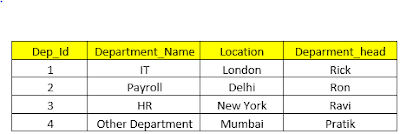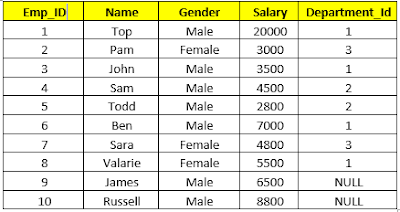SQL Server GROUP BY Statement
The GROUP BY statement groups rows that have the same values into summary rows, like "find the number of customers in each country".
The GROUP BY statement is often used with aggregate functions (COUNT, MAX, MIN, SUM, AVG) to group the result-set by one or more columns.
SQL Script to create Employee and Department tables.
Create table Department ( Dep_Id int primary key identity(1,1), Department_Name varchar (50), Location varchar (50), Department_Head varchar (50) ) insert into Department values('IT','London','Rick') insert into Department values('Payroll','Delhi','Ron') insert into Department values('HR','New York','Ravi') insert into Department values('Other Department','Mumbai','Pratik') Create table Employee ( Emp_Id int primary key identity(1,1), Name varchar (50), Gender varchar(50), salary int, Department_Id int references Department(Dep_Id) ) insert into Employee values('Top','Male',20000,1) insert into Employee values ('Pam', 'Female', 3000, 3) Insert into Employee values ( 'John', 'Male', 3500, 1) Insert into Employee values ('Sam', 'Male', 4500, 2) Insert into Employee values ( 'Todd', 'Male', 2800, 2) Insert into Employee values ('Ben', 'Male', 7000, 1) Insert into Employee values ('Sara', 'Female', 4800, 3) Insert into Employee values ( 'Valarie', 'Female', 5500, 1) Insert into Employee values ( 'James', 'Male', 6500, NULL) Insert into Employee values ( 'Russell', 'Male', 8800, NULL)
Department Table
Employee Table
Write a query, to retrieve total salaries paid by Gender, The output should be as shown below.
Query for retrieving total salaries by Gender.
select Gender, Sum(salary) as TotalSalary from Employee group by Gender
We are applying SUM() aggregate function on Salary column, and grouping by Gender column. This effectively adds, all salaries of employees with in the same Gender
Note: If you omit, the group by clause and try to execute the query, you get an error - Column 'tblEmployee.City' is invalid in the select list because it is not contained in either an aggregate function or the GROUP BY clause.
Write a query, to retrieve total salaries paid by Gender and total number of Employees by Gender, The output should be as shown below.
Query for retrieving total salaries and total number of employees by Gender.
select Gender, sum(salary) as TotalSalary, count(Emp_Id) as TotalEmployee from Employee group by Gender
The only difference here is that, we are using Count() aggregate function.
Filtering Groups:
WHERE clause is used to filter rows before aggregation, where as HAVING clause is used to filter groups after aggregations. The following 2 queries produce the same result.
Filtering rows using WHERE clause, before aggrgations take place:
select Gender, sum(salary) as TotalSalary, count(Emp_Id) as totalEmployee from Employee where Gender='Male' group by Gender
Filtering groups using HAVING clause, after all aggrgations take place:
select Gender, sum(salary) as TotalSalary, count(Emp_Id) as totalEmployee from Employee group by Gender having Gender='Male'
Write a query, to retrieve Minimum salaries paid by Department using join. The output should be as shown below.
Query for retrieving minimum salaries by Department Name.
select Department.Department_Name, Min(Employee.salary) as MinimumSalary from Department join Employee on Department.Dep_Id= Employee.Department_Id group by Department.Department_Name
Write a query, to retrieve Minimum salaries paid by Department and total number of employees using join. The output should be as shown below.
Query for retrieving minimum salaries by Department Name and total number of employee.
select Department.Department_Name, Min(Employee.salary) as MinimumSalart, count(Employee.Emp_Id) as TotalEmployee from Department join Employee on Department.Dep_Id= Employee.Department_Id group by Department.Department_Name
The only difference here is that, we are using Count() aggregate function.
If you want to retrieve Max salary of employee then just replace MIN to MAX in query.
Filtering rows using WHERE clause, before aggrgations take place:
select Department.Department_Name, Min(Employee.salary) as MinimumSalart, count(Employee.Emp_Id) as TotalEmployee from Department join Employee on Department.Dep_Id= Employee.Department_Id where Department.Department_Name='IT' group by Department.Department_Name
OR
select Department.Department_Name, Min(Employee.salary) as MinimumSalart, count(Employee.Emp_Id) as TotalEmployee from Department join Employee on Department.Dep_Id= Employee.Department_Id where Department.Dep_Id=1 group by Department.Department_Name









No comments:
Post a Comment